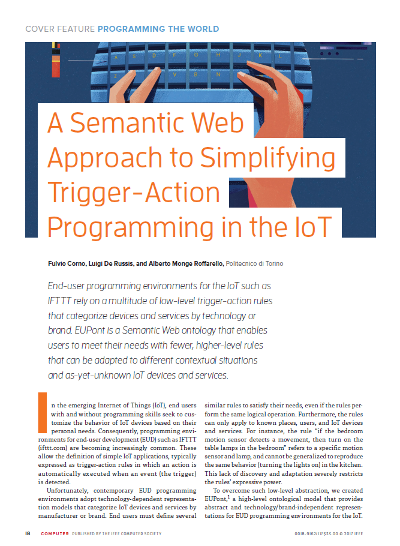End-User Development (EUD) platforms in the Internet of Things (IoT) allow users to define and tailor joint behaviors between IoT devices and services in various areas, like the home, the car, or for a healthy lifestyle, typically through trigger-action rules. Such platforms are successful in terms of user understandability and ease of use, but they exhibit various issues and challenges as the number of available interconnected "things" grow. For instance, a user cannot create an IoT application that can be applied to all her connected lamps, unless they are equally branded, nor to other kinds of devices that may provide interior lighting.
We recently published a paper in the "Programming the World" special issue of Computer, an IEEE Computer Society magazine, in which we present EUPont as a starting point towards a solution for the challenges brought by contemporary EUD platforms. EUPont is a Semantic Web ontology that enables users to personalize the joint behaviors between their IoT devices with fewer, higher-level rules than contemporary plaforms. Such rules can be also adapted to different contextual situations and as-yet-unknown IoT devices and services.
In the paper, we show how EUPont could improve the rule composition process, and we evaluate its expressiveness by presenting an automated translation procedure of 290,963 rules shared on the IFTTT programming environment, one of the most popular EUD platforms. Results show that EUPont improves the rule composition process for end-users in terms of correctness and needed time. Furthermore, the evaluation confirms that the model is more expressive than the one adopted by IFTTT, one of the most common solutions in this field.
More information:
- Paper in IEEE Xplore
- Paper on PORTO
- DOI: 10.1109/MC.2017.4041355


